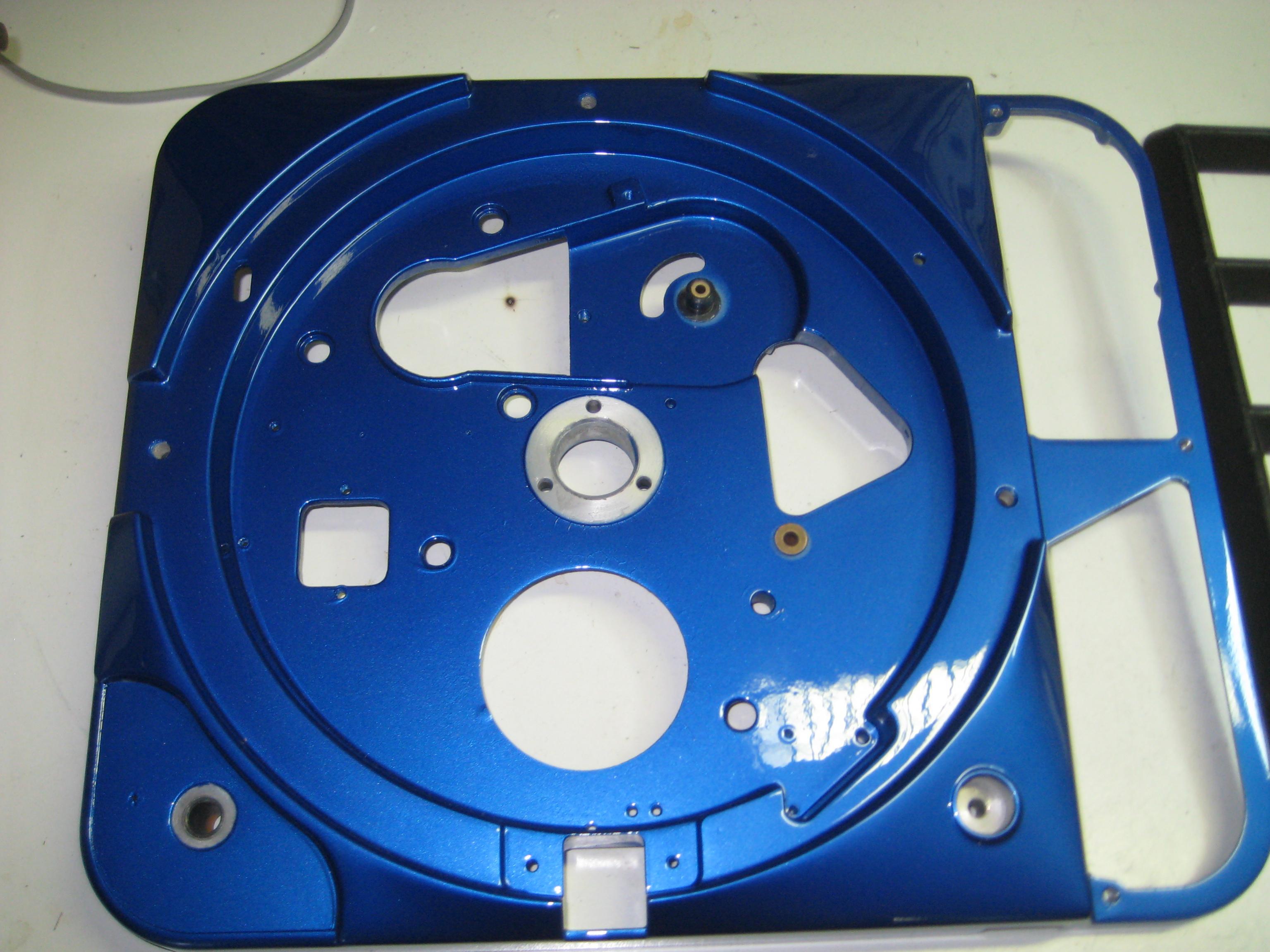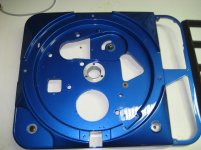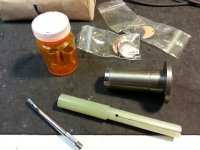Main bearing replacement
To recap,
I recently received from my brother a low-serial number 124 to rebuild.
The platter bearings are the early plastic ones, and of course I plan on replacing them.
I've heard, (From Kevin?) that many of the replacement bearings being offered fit too loosely in the housing.
I sent a letter to the gentleman from Spain who advertises on Ebay, and this is his reply, (I asked if he could measure the OD of the main bearing bushings he sells for me.)
"Dear tesla5lnx, Hi, I am not able to measure with high precision the dimater. But I have used this for my thorens 124 and I have sold a lot without any claim. I am sure it will work well for your thorens 124. Regards Ramiro -thorens_parts"
At first blush, this does not make me confident in his product.
Any remarks? Anyone used his, or anyone elses with success?
To recap,
I recently received from my brother a low-serial number 124 to rebuild.
The platter bearings are the early plastic ones, and of course I plan on replacing them.
I've heard, (From Kevin?) that many of the replacement bearings being offered fit too loosely in the housing.
I sent a letter to the gentleman from Spain who advertises on Ebay, and this is his reply, (I asked if he could measure the OD of the main bearing bushings he sells for me.)
"Dear tesla5lnx, Hi, I am not able to measure with high precision the dimater. But I have used this for my thorens 124 and I have sold a lot without any claim. I am sure it will work well for your thorens 124. Regards Ramiro -thorens_parts"
At first blush, this does not make me confident in his product.
Any remarks? Anyone used his, or anyone elses with success?

Above pic: Checking for main bearing slop out at the flywheel rim. Consider the leverage involved. A few 'tenths of clearance between sleeve and shaft ( .0003" ) gets multiplied by the distance from bearing center to the rim.
That's one way to check.
Fwiw, it took me a few times to learn that pressing in new replacement bushings can result in damage to the bushing sleeve unless adequate care is taken to avoid distorting the sleeve during the press-in process. These days I go to the trouble of using a spare bearing shaft as a pilot to align the bushing sleeve during the press. I should get some photos of that process. Presently, I haven't documented it.
Fwiw 2, I've been using Oilite bushings (14mm ID) from McMaster-Carr with good results. Typically after new sleeves are installed I see just less than .001 of indicated free-play out at the platter rim (like in the above picture).
Fwiw 3, The Oilite bushings sleeves are very soft material and will shrink their ID by the amount of interference in the press between sleeve and housing. In my measurements .001" of press results in a reduction to the ID by the same amount. That's pretty soft stuff.
-Steve
McMaster-CarrI have a custom made tool I use for pressing in bushings, the problem I have had is the bushings I have purchased previously do not fit tightly enough in the bearing housing.
A part number for the 14mm id bushing you have used successfully would be helpful..
McMaster-Carr
Material: SAE 841
part number: 6658K22
dimensions:
OD: 18mm
ID: 14mm
Length: 18mm
Price: $1.63 each sleeve
fwiw, I'm curious (again) about the original Nylon bushing sleeves. I wonder if we haven't been too quick to dismiss them. Just thinking out loud.
-Steve
<snip>
fwiw, I'm curious (again) about the original Nylon bushing sleeves. I wonder if we haven't been too quick to dismiss them. Just thinking out loud.
-Steve
The nylon bearings seize and to my considerable surprise can do quite a lot of damage to the spindle - deep scoring at the edges and heavy scuffing within the bushing bore - I've rarely seen a turntable spindle more severely worn than ones run with nylon bushings. I have worked on 4 tables with nylon bushings in the bearing housing and had to replace the spindle in one of them. I haven't seen any that were in running condition - apparently the lubricant used caused them to swell slightly over time, worst case it is so bad that the platter will not turn at all, and getting the spindle out under those circumstances can be difficult. (First hand experience)
Any thoughts on using the 22mm length bearing?
From my perspective the slight added drag with modern lubricants would not be a bad thing as it might allow backing off the eddy current brake a bit which in both my tables is running with about as much braking force as these eddy current brakes will make. The magnets are good. The brakes get noisier the closer the magnet is to the intermediate pulley.
From my perspective the slight added drag with modern lubricants would not be a bad thing as it might allow backing off the eddy current brake a bit which in both my tables is running with about as much braking force as these eddy current brakes will make. The magnets are good. The brakes get noisier the closer the magnet is to the intermediate pulley.
The nylon bearings seize and to my considerable surprise can do quite a lot of damage to the spindle when they start to seize. I have worked on 4 tables with nylon bushings in the bearing housing and had to replace the spindle in one of them. I haven't seen any that were in running condition - apparently the lubricant used caused them to swell slightly over time, worst case it is so bad that the platter will not turn at all, and getting the spindle out under those circumstances can be difficult. (First hand experience)
I saw one situation where a mk1 with nylon sleeves had actually siezed onto the bearing shaft. Here's a pic:

Looks like its trashed, right!
But when I mic'd the od in the wear areas, guess what..........it checked slightly oversize. Looked at under magnification it could be seen that the nylon bushing sleeve material had actually welded itself onto the surface of the hardened steel shaft, causing the shaft diameter to increase.
Then, after careful polishing with 600 grit and 1200 grit wet/dry sandpaper, nominal size was restored:

Probably I was lucky to be able to save this bearing shaft. If the original nylon sleeves had seized up any tighter, real damage might have been done.
At least this is the perspective I'm looking through when I wonder if there isn't a way to benefit from new nylon bushings. I'd imagine lube should be silicone based. And then the bearing would need to be periodically topped up with lube.
My reason for consideration along these lines is that the nylon sleeves were used on the early production models, but not the later ones. So I guess that Thorens must have learned from their customers that there was a problem. And I'd also guess that the problem was either; a) wrong lube installed......or......b)a frequent need to check lube levels within the housing to prevent the bearing running dry.....and then seizing up.
In any case, the Oilite sleeves are an obvious fix and have a long history of holding up well.
re: 22mm length. I'd guess that sleeve length is optional. The housing is a straight through bore. I'd imagine that greater sleeve to shaft contact areas will result in slightly higher noise levels generated by that bearing. Probably shorter is better than longer. But a 'radically minimal' length might result in premature wear to the shaft. So stock length seems like a safe bet to me.
-Steve
Last edited:
Custom made tool
Can you show us please some pictures of your tool.
regards Ronald
I have a custom made tool I use for pressing in bushings, the problem I have had is the bushings I have purchased previously do not fit tightly enough in the bearing housing.
A part number for the 14mm id bushing you have used successfully would be helpful..
Can you show us please some pictures of your tool.
regards Ronald
I just bought some bushings from the Spanish seller on eBay and will report back with the results once I install them.
I look forward to hearing how they work for you, as I've got a set from him on the shelf awaiting my rebuild. FWIW, I haven't gotten to mine because all my time seems to be taken up working on building a new room upstairs - which my wife suspects will end up with one of my work benches in it!
Wish I had something to add to the discussion (like how the Nye oil performs), particularly since I see in recent months some of you more experienced owners have added information that will certainly help me along. & Kevinkr, do hope you're doing better.
Just received my chassis back from Swiss in Ciel Bleu !
Volken
Looks very nice Jaap
Please place pictures when rebuild.
Regards Ronald
Just received my chassis back from Swiss in Ciel Bleu !
Volken
is that baked enamel??
Just received my chassis back from Swiss in Ciel Bleu !

Volken
Cool. Dark blue metalic. Almost a "candy" blue. I like it.
That brings up a future project. I have one mk1 chassis that is in need of a repaint. And I've been mulling over what to paint that one. But I know it will receive the Papst Aussenlauffer motor I picked up a while back. Non standard all the way.
Volken. what is this blue one going to have for mechanicals?
-Steve
Volken. what is this blue one going to have for mechanicals? Inquiring minds want to know
Ronald ,Steve I post the rebuilding proces soon !
With the Papst motor spring decoupled and phase tuning for min.vibration !
Treatment of the chassis is powder coating.
Volken
Powder coat, great! I was about to ask if anyone had tried powder coating, so I guest the answer is yes!
Spanish Bearings
Tonight I got home at the onset of yet another blizzard to an altogether more pleasant surprise - a small international package containing a set of main bearing oilite bushings for my second TD-124/I.
I pulled the bearing assembly out of the table and all too easily popped out the previous set of replacement bushings from a U.S. seller and indeed the bottom bushing had traveled an inch or so up the bearing bore due to the hydrostatic pressure developed during insertion of the spindle.
The new bushings fit extremely snuggly in the bore, but the spindle turns freely. Pressing them in was done with the tool shown below and a bench vise. They ain't going to budge! Good!
When I put it all back together I installed a mild steel thrust plate and a stainless steel end cap I have been saving for this occasion.
I am awaiting for the sealant (automotive rtv) to set up and then I will install and refill the housing.
Will report back later, but at this point it looks like the Spanish seller on eBay is selling good bushings - they look considerably better than what I took out actually.
Tonight I got home at the onset of yet another blizzard to an altogether more pleasant surprise - a small international package containing a set of main bearing oilite bushings for my second TD-124/I.
I pulled the bearing assembly out of the table and all too easily popped out the previous set of replacement bushings from a U.S. seller and indeed the bottom bushing had traveled an inch or so up the bearing bore due to the hydrostatic pressure developed during insertion of the spindle.
The new bushings fit extremely snuggly in the bore, but the spindle turns freely. Pressing them in was done with the tool shown below and a bench vise. They ain't going to budge! Good!
When I put it all back together I installed a mild steel thrust plate and a stainless steel end cap I have been saving for this occasion.
I am awaiting for the sealant (automotive rtv) to set up and then I will install and refill the housing.
Will report back later, but at this point it looks like the Spanish seller on eBay is selling good bushings - they look considerably better than what I took out actually.
Attachments
Tonight I got home at the onset of yet another blizzard to an altogether more pleasant surprise - a small international package containing a set of main bearing oilite bushings for my second TD-124/I.
Will report back later, but at this point it looks like the Spanish seller on eBay is selling good bushings - they look considerably better than what I took out actually.
Kevinkr - I remember you talking about the tool you made, but question - is the metal piece in the photo part of the tool & how does it work? Something done to spread out the pressing tool, then you pull out the metal to reduce the pressure? Also, User510 recently posed a pic showing how he measured travel. Will you be doing something similar now that you have the new bushings in? I'm curious, of course, since I've got a set from the same vendor awaiting time to install.
Oh, and sorry about that storm, man. We're cold here - but dry.
- Home
- Source & Line
- Analogue Source
- Restoring and Improving A Thorens TD-124 MKII
 Items for sale should be placed in the vendor forums under swap meet and not in the general forums per forum policy. Since the item has sold the related posts have been deleted. Please do not do this again. Thank You.
Items for sale should be placed in the vendor forums under swap meet and not in the general forums per forum policy. Since the item has sold the related posts have been deleted. Please do not do this again. Thank You.
